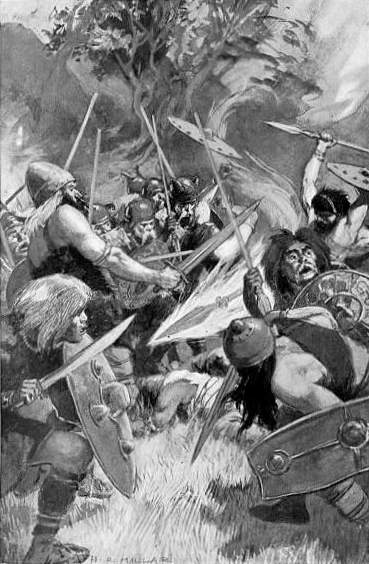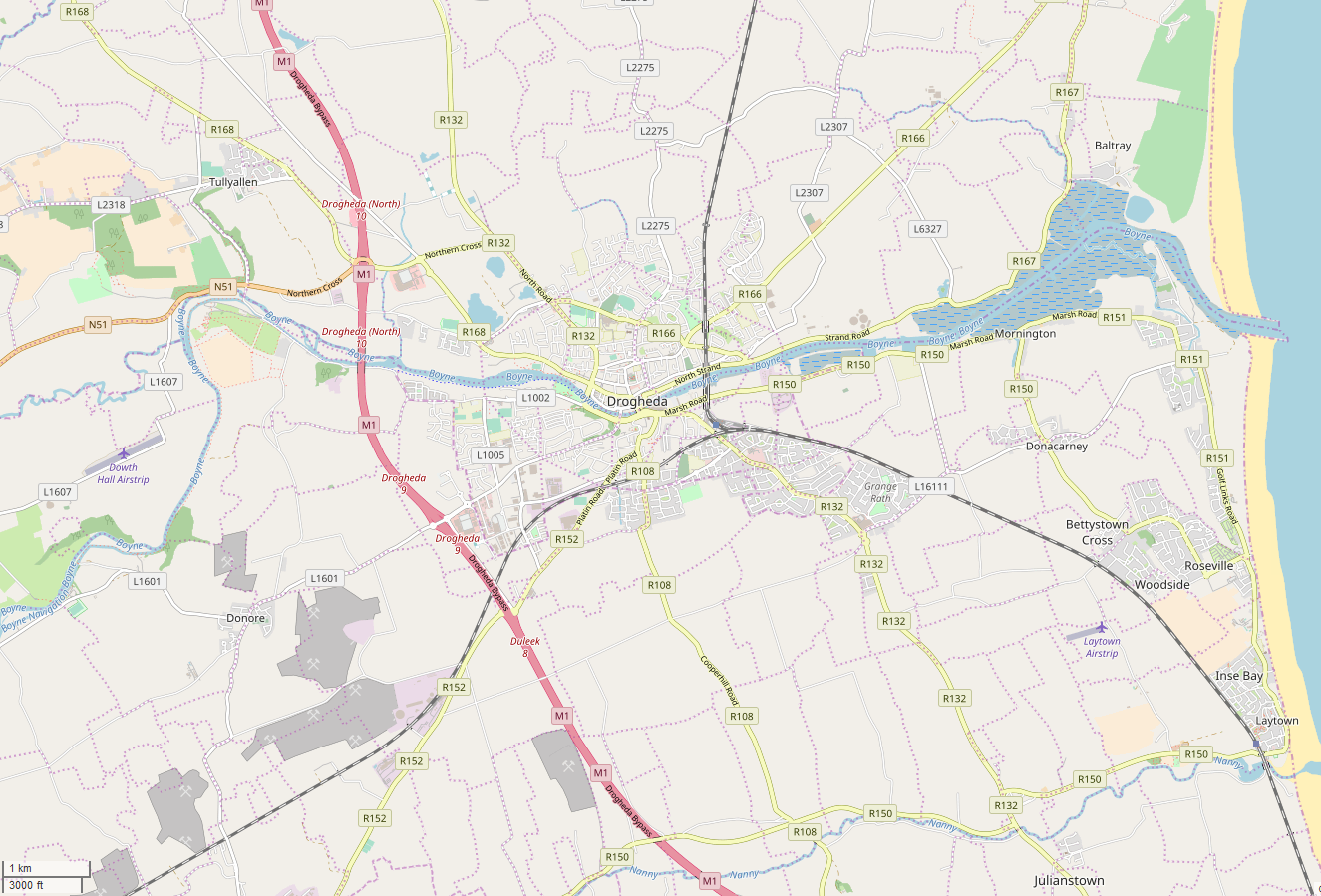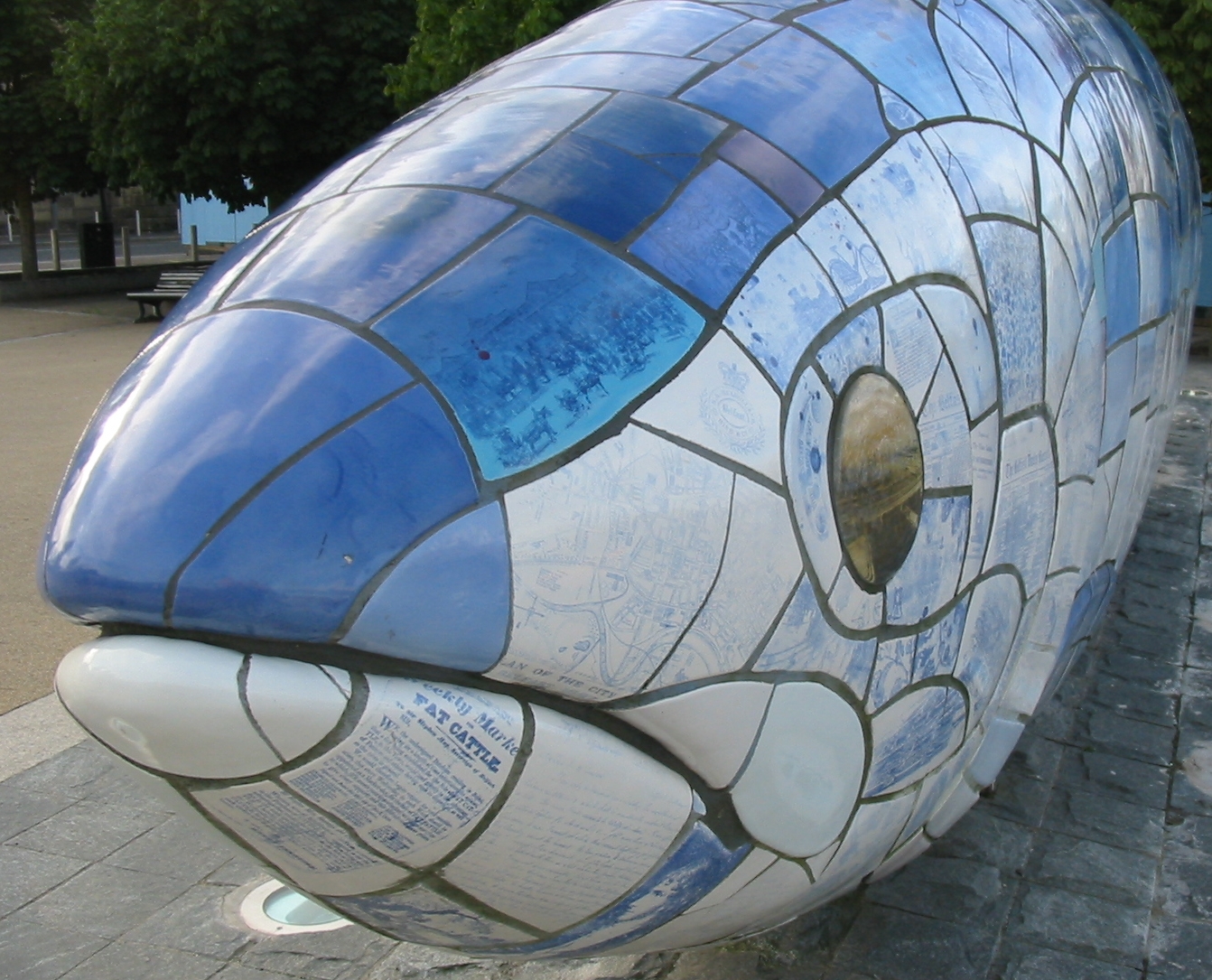|
The Boyne
The River Boyne ( or ''Abhainn na Bóinne'') is a river in Leinster, Ireland, the course of which is about long. It rises at Trinity Well, Newberry Hall, near Carbury, County Kildare, and flows north-east through County Meath to reach the Irish Sea between Mornington, County Meath, and Baltray, County Louth. Names and etymology This river has been known since ancient times. The Greek geographer Ptolemy drew a map of Ireland in the 2nd century that included the Boyne, which he called (''Bouwinda'') or (''Boubinda''), which in Celtic means "white cow" (). During the High Middle Ages, Giraldus Cambrensis called it the ''Boandus''. In Irish mythology it is said that the river was created by the goddess Boann and Boyne is an anglicised form of the name. In other legends, it was in this river where Fionn mac Cumhail captured Fiontán, the Salmon of Knowledge. The Meath section of the Boyne was also known as ''Smior Fionn Feidhlimthe'' (the 'marrow of Fionn Feilim'). The tidal ... [...More Info...] [...Related Items...] OR: [Wikipedia] [Google] [Baidu] |
Proto-Celtic
Proto-Celtic, or Common Celtic, is the hypothetical ancestral proto-language of all known Celtic languages, and a descendant of Proto-Indo-European. It is not attested in writing but has been partly Linguistic reconstruction, reconstructed through the comparative method. Proto-Celtic is generally thought to have been spoken between 1300 and 800 BC, after which it began to split into different languages. Proto-Celtic is often associated with the Urnfield culture and particularly with the Hallstatt culture. Celtic languages share common features with Italic languages that are not found in other branches of Indo-European, suggesting the possibility of an earlier Italo-Celtic linguistic unity. Proto-Celtic is currently being reconstructed through the comparative method by relying on later Celtic languages. Though Continental Celtic presents much substantiation for Proto-Celtic phonology, and some for its morphology (linguistics), morphology, recorded material is too scanty to allow ... [...More Info...] [...Related Items...] OR: [Wikipedia] [Google] [Baidu] |
Irish Mythology
Irish mythology is the body of myths indigenous to the island of Ireland. It was originally Oral tradition, passed down orally in the Prehistoric Ireland, prehistoric era. In the History of Ireland (795–1169), early medieval era, myths were Early Irish literature, written down by Celtic Christianity, Christian scribes, who Christianized them to some extent. Irish mythology is the best-preserved branch of Celtic mythology. The myths are conventionally grouped into 'List of literary cycles, cycles'. The Mythological Cycle consists of tales and poems about the god-like Tuatha Dé Danann, who are based on Ireland's pagan deities, and other mythical races like the Fomorians. Important works in the cycle are the ''Lebor Gabála Érenn'' ("Book of Invasions"), a legendary history of Ireland, the ''Cath Maige Tuired'' ("Battle of Moytura"), and the ''Aided Chlainne Lir'' ("Children of Lir"). The Ulster Cycle consists of heroic legends relating to the Ulaid, the most important of whi ... [...More Info...] [...Related Items...] OR: [Wikipedia] [Google] [Baidu] |
M1 Motorway (Republic Of Ireland)
The M1 motorway () is a motorway in Ireland. It forms the large majority of the N1 national primary road connecting Dublin towards Belfast along the east of the island of Ireland. The route heads north via Swords, Drogheda and Dundalk to the Northern Irish border just south of Newry in County Armagh, where it joins the A1 road and further on, the M1 motorway in Northern Ireland. It also forms a significant part of the road connection between Dublin and the Northern Irish cities of Newry, and Lisburn. The route is part of European route E01. Route Almost the entire length of the N1 has been upgraded to motorway standard and is designated the M1 motorway. It runs from the Junction 3 of the M50 ring road in Dublin, past Cloghran, Swords, Balbriggan, Stamullen, Drogheda, Dunleer, Castlebellingham and Dundalk before ending at Ballymascanlon north of Dundalk. It by-passes many towns and villages through which the N1 travelled. The original N1 route now forms the R132. At Ball ... [...More Info...] [...Related Items...] OR: [Wikipedia] [Google] [Baidu] |
Mary McAleese Boyne Valley Bridge
The Mary McAleese Boyne Valley Bridge () is a cable-stayed bridge in County Meath, and County Louth, Ireland. It spans the River Boyne west of Drogheda on the county boundary between County Meath and County Louth and is part of the M1 Motorway. When it opened in June 2003, it was the longest cable-stayed bridge in Ireland until 19 October 2009, when the River Suir Bridge opened on the N25. Due to environmental concerns, an Environmental Impact Statement (EIS) was carried out for the bridge separately from the M1 EIS—the first such formal EIS carried out and published for a bridge in Ireland. The bridge was built between 2000 and 2003. It was designed Roughan & O'Donovan consulting engineers, who were awarded the Association of Consulting Engineers of Ireland (ACEI) Presidential Award in 2005 for the design. Overview Designing a road bridge over the Boyne was not an easy task. At the chosen point, upstream from Drogheda, the ground level on the south is elevated, with a s ... [...More Info...] [...Related Items...] OR: [Wikipedia] [Google] [Baidu] |
Drogheda
Drogheda ( , ; , meaning "bridge at the ford") is an industrial and port town in County Louth on the east coast of Ireland, north of Dublin. It is located on the Dublin–Belfast corridor on the east coast of Ireland, mostly in County Louth but with the south fringes of the town in County Meath, north of Dublin city centre. Drogheda had a population of 44,135 inhabitants in 2022, making it the List of settlements on the island of Ireland by population, eleventh largest settlement by population in all of Ireland, and the largest town in Ireland, by both population and area. It is the second largest in County Louth with 35,990 and sixth largest in County Meath with 8,145. It is the last bridging point on the River Boyne before it enters the Irish Sea. The UNESCO World Heritage Site of Newgrange is located west of the town. Area Drogheda was founded as two separately administered towns in two different territories: Drogheda-in-Kingdom of Meath, Meath (i.e. the Lordship of Mea ... [...More Info...] [...Related Items...] OR: [Wikipedia] [Google] [Baidu] |
Brú Na Bóinne
(, "mansion or palace of the Boyne"), also called the Boyne Valley tombs, is an ancient monument complex and ritual landscape in County Meath, Republic of Ireland, Ireland, located in a bend of the River Boyne. It is one of the world's most important Neolithic landscapes, comprising at least ninety monuments including passage tombs, burial mounds, standing stones and Enclosure (archaeology), enclosures. The site is dominated by the passage tombs of Newgrange (), Knowth () and Dowth (), built during the 32nd century BC. Together these have the largest assemblage of megalithic art in Europe. The associated archaeological culture is called the "Boyne culture". ''Brú na Bóinne'' is also an important archaeoastronomical site; several of the passage tombs are aligned with the winter solstice and equinoxes. The area continued to be a site of ritual and ceremonial activity in the later Bronze Age Europe, Bronze Age and Iron Age Europe, Iron Age. In Irish mythology, the tombs are said ... [...More Info...] [...Related Items...] OR: [Wikipedia] [Google] [Baidu] |
Dindsenchas
''Dindsenchas'' or ''Dindshenchas'' (modern spellings: ''Dinnseanchas'' or ''Dinnsheanchas'' or ''Dınnṡeanċas''), meaning "lore of places" (the modern Irish word ''dinnseanchas'' means "topography"), is a class of onomastic text in early Irish literature, recounting the origins of place-names and traditions concerning events and characters associated with the places in question. Since many of the legends being related also concern the acts of mythic and legendary figures, the ''dindsenchas'' has been an important source for the study of Irish mythology. Works The literary corpus of the ''dindsenchas'' comprises about 176 poems plus a number of prose commentaries and independent prose tales (the so-called "prose ''dindsenchas''" is often distinguished from the "verse", "poetic" or "metrical ''dindsenchas''"). As a compilation the ''dindsenchas'' has survived in two different recensions. The first recension is found in the '' Book of Leinster'', a manuscript of the 12th century, ... [...More Info...] [...Related Items...] OR: [Wikipedia] [Google] [Baidu] |
Milesians (Irish)
The Milesians or sons of Míl are the final race to settle in Ireland, according to the ''Lebor Gabála Érenn'', a medieval Irish Christian history. The Milesians represent the Irish people. They are Gaels who sail to Ireland from Iberia (Hispania) after spending hundreds of years travelling the Earth. When they land in Ireland, they contend with the Tuatha Dé Danann, who represent the Irish pantheon of gods. The two groups agree to divide Ireland between them: the Milesians take the world above, while the Tuath Dé take the world below (i.e. the Celtic Otherworld, Otherworld). Scholars believe that the tale is mostly an invention of medieval Christian writers.John Carey (Celticist), Carey, John''The Irish National Origin-Legend: Synthetic Pseudohistory'' University of Cambridge, 1994. pp.1–4 Myth ''Historia Brittonum'' The 9th century Latin work ''Historia Brittonum'' (History of the Britons) says that Ireland was settled by three groups of people from the Iberian Peninsu ... [...More Info...] [...Related Items...] OR: [Wikipedia] [Google] [Baidu] |
Míl Espáine
In Irish origin myths, Míl Espáine or Míl Espáne (later Latinization of names, Latinized as Milesius) is the mythical ancestor of the final inhabitants of Ireland, the "sons of Míl" or Milesians (Irish), Milesians, who represent the vast majority of the Irish Gaels. His father was Bile (Irish legend), Bile, son of Breogan. Modern historians believe he is a creation of medieval Irish Christian writers. Name and origin Mark Williams characterises the name ''Míl Espáine'' as an "etymological figment" translated from the Latin ''mīles Hispaniae'', meaning "soldier of Hispania (Spain)", attested in a passage (§ 13) in the 9th-century work ''Historia Brittonum'' (''"The History of the Britons"'') by Nennius. As A.G. van Hamel has suggested, the status of Iberia as the land of origin can be traced back to Isidore of Seville, who in the introduction to his Historia de regibus Gothorum, Vandalorum et Suevorum, history of the Goths, Vandals and Suebi had elevated Iberia/Hispania ... [...More Info...] [...Related Items...] OR: [Wikipedia] [Google] [Baidu] |
Acallam Na Senórach
''Acallam na Senórach'' (, whose title in English has been given variously as ''Colloquy of the Ancients'', ''Tales of the Elders of Ireland'', ''The Dialogue of the Ancients of Ireland'', etc.), is an important prosimetric Middle Irish narrative dating to 1200. It is the most important text of the Finn Cycle (also known as the Fenian Cycle, ''fíanaigecht'', ''fiannaigheacht'', ''fiannaíocht'' etc) and at about 8,000 lines is the longest-surviving work of medieval Irish literature. It contains many Finn Cycle narratives framed by a story in which the '' fianna'' warriors and Caílte mac Rónáin have survived long enough to relate the tales to Saint Patrick. The work has been seen as a defence of the Irish literary establishment when it came under the scrutiny of Church reformers during the 12th to 13th centuries. Contents Set several hundred years after the death of Finn mac Cumhaill, the frame story follows two aged Irish heroes as they travel Ireland with a newly arri ... [...More Info...] [...Related Items...] OR: [Wikipedia] [Google] [Baidu] |
Mattock River
The Mattock River is a river in Ireland. It is a tributary of the River Boyne. Its source is near Collon (), from where it flows through County Louth towards the southeast until a place west of Drummond Tower in Coolfore where it begins to form the boundary between Counties Meath and Louth. Here it turns towards the southwest until Monknewtown where it takes a southeastern direction again before turning roughly east at Dowth. It joins the River Boyne at Oldbridge in the parish of Drogheda Drogheda ( , ; , meaning "bridge at the ford") is an industrial and port town in County Louth on the east coast of Ireland, north of Dublin. It is located on the Dublin–Belfast corridor on the east coast of Ireland, mostly in County Louth ... (). The estimated terrain elevation above sea level is 10 metres. References {{Reflist Rivers of County Louth Rivers of County Meath ... [...More Info...] [...Related Items...] OR: [Wikipedia] [Google] [Baidu] |
Salmon Of Knowledge
The Salmon of Knowledge () is a creature in the Fenian Cycle of Irish mythology, sometimes identified with Fintan mac Bóchra, who was known as "The Wise" and was once transformed into a salmon. Fenian Cycle The Salmon story figures prominently in ''The Boyhood Deeds of Fionn'', which recounts the early adventures of Fionn mac Cumhaill. In the story, an ordinary salmon ate nine hazelnuts that fell into the Well of Wisdom (''an Tobar Segais'') from nine hazel trees that surrounded the well. By this act, the salmon gained all the world's knowledge. The first person to eat of its flesh would in turn gain this knowledge. The poet Finn Eces (or Finegas) spent seven years fishing for this salmon. Finally Finn caught the salmon and gave the fish to Fionn, his servant and son of Cumhaill, with instructions to cook it but on no account eat any of it. Fionn cooked the salmon, turning it over and over, but when he touched the fish with his thumb to see if it was cooked, he burnt his f ... [...More Info...] [...Related Items...] OR: [Wikipedia] [Google] [Baidu] |





